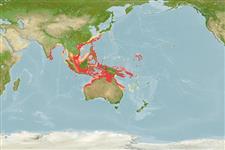>
Eupercaria/misc (Various families in series Eupercaria) >
Nemipteridae (Threadfin breams, Whiptail breams)
Etymology: Nemipterus: Greek, nema, -atos = filament + Greek, pteron = wing, fin (Ref. 45335).
More on author: Valenciennes.
Environment: milieu / climate zone / depth range / distribution range
Ecologie
marien; brak water rifbewoner; standvastig; diepte 8 - 110 m (Ref. 9785). Tropical; 34°N - 26°S, 76°E - 172°E (Ref. 3810)
Indian Ocean: Maldives (Ref. 30829), Gulf of Mannar, Sri Lanka, Andaman Sea, Strait of Malacca and northwestern Australia. Western Pacific: southern Japan to northeastern Australia. Most authors have incorrectly applied the name Nemipterus peronii to this species.
Lengte bij maturiteit / Grootte / Gewicht / Leeftijd
Maturity: Lm 16.6, range 13 - ? cm
Max length : 24.0 cm SL mannelijk / geslacht onbekend; (Ref. 48635); common length : 18.0 cm SL mannelijk / geslacht onbekend; (Ref. 3810)
Dorsale stekels (totaal): 10; Dorsale zachte stralen (totaal): 9; Anale stekels 3; Anale zachte stralen: 7. Suborbital spine absent. Preopercle with 3 transverse scale rows. Pectoral fins moderately long, reaching to or just short of level of anus. Pelvic fins moderately long, reaching to or just short of level anus. A line drawn up from posterior edge of suborbital reaching the dorsal profile at about the origin of dorsal fin. Females predominate at small sizes while males dominate the larger size classes. Maybe a sequential hermaphrodite. Axillary scale present. Color: Upper body iridescent pink, silvery white below. Lower margin of caudal fin white.
Inhabits sandy and muddy bottoms; also in sheltered estuaries (Ref. 48635). Feeds mainly on crustaceans and small fishes. Principal catch in the Taiwanese pair-trawl fishery off the coast of northwestern Australia. Good food fish (Ref. 171).
Females predominate at small size classes while males dominate the larger size classes, and there is some evidence that this species is a sequential hermaphrodite.
Russell, B.C., 1990. FAO Species Catalogue. Vol. 12. Nemipterid fishes of the world. (Threadfin breams, whiptail breams, monocle breams, dwarf monocle breams, and coral breams). Family Nemipteridae. An annotated and illustrated catalogue of nemipterid species known to date. FAO Fish. Synop. 125(12):149p. Rome: FAO. (Ref. 3810)
Status op de Rode Lijst van het IUCN (Ref. 130435)
Gevaar voor de mens
Harmless
Gebruik door de mens
Visserij: commercieel
Meer informatie
ReferentiesAquacultuurAquacultuurprofielKweeklijnenGeneticaElectrophoresesErfelijkheidZiektesVerwerkingNutrientsMassaconversie
Tools
Speciale rapporten
Download XML
Internetbronnen
Estimates based on models
Preferred temperature (Ref.
123201): 24.8 - 29, mean 28 °C (based on 1360 cells).
Fylogenetische diversiteitsindex (Ref.
82804): PD
50 = 0.5000 [Uniqueness, from 0.5 = low to 2.0 = high].
Bayesian length-weight: a=0.01380 (0.01135 - 0.01678), b=2.97 (2.93 - 3.01), in cm total length, based on LWR estimates for this species (Ref.
93245).
Trofisch niveau (Ref.
69278): 3.7 ±0.0 se; based on diet studies.
Generation time: 2.6 ( na - na) years. Estimated as median ln(3)/K based on 2
growth studies.
Weerstandsvermogen (Ref.
120179): Hoog, minimale populatieverdubbelingstijd minder dan 15 maanden (K=0.25-0.4).
Fishing Vulnerability (Ref.
59153): Low to moderate vulnerability (28 of 100).
Nutrients (Ref.
124155): Calcium = 148 [33, 400] mg/100g; Iron = 0.636 [0.184, 2.056] mg/100g; Protein = 18.9 [17.0, 20.7] %; Omega3 = 0.192 [0.090, 0.430] g/100g; Selenium = 25.8 [8.6, 77.9] μg/100g; VitaminA = 39 [6, 247] μg/100g; Zinc = 1.03 [0.53, 3.29] mg/100g (wet weight);
